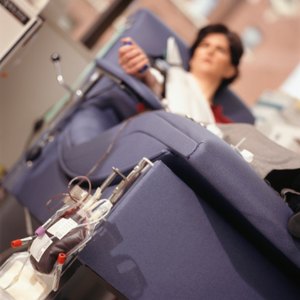
Plasma makes up the majority of blood's volume, containing proteins and other nutrient components. Its primary function is as a conveyance of nutrients, proteins and hormones to needy parts of the human body. Apart from platelets, red blood cells and white blood cells, plasma is a yellowish liquid that also transports salts, enzymes and water.
Separating plasma from blood allows for therapies that call for antibodies and proteins found in plasma. Such conditions include autoimmune disorders as well as burns, shocks and other traumas. This is why blood donations are often separated for the use of plasma. Additionally, plasma donations are needed and often compensated.
How Does Plasma Donation Work?
Before donating plasma takes place, a prospective donor's blood must be evaluated as to its health. Generally, sickle-cell anemia, malaria, chronic heart disease and some types of cancer preclude a candidate from donating plasma. Once screened and qualified, a donor is ready for the procedure which, superficially, looks like a regular blood donation.
A needle draws blood from an arm but that blood is sent to a machine that divides the plasma from the other elements. This separation is called plasmapheresis. When this is completed, the remaining components are, with the assistance of a saline solution, returned to the donor's body, partially replenishing what was withdrawn.
Read More: 8 Ways to Make Extra Cash for the Holidays
Is Plasma Donation Dangerous?
Plasma donation is not right for everyone. Those suffering from the conditions named above are usually prevented from partaking in the procedure. Moreover, those who are not properly hydrated or are under-nourished should avoid donating plasma because plasma contains large percentages of water, salts and other nutrients.
For the most part, this is a safe enterprise for people over 110 pounds who are between 18 and 65. Actually, because some of the blood constituents are returned to the body, people can donate plasma more often than they can give up a pint of whole blood.
Read More: How to Donate Plasma for Money in Texas
Why Pay for Just Plasma?
The nutritive elements of plasma, detached from the other constituents, are readily available for the therapies and treatments noted above. Drawing plasma, unlike blood, is time-consuming, often requiring an hour plus to complete the process of extraction and return of the red and white blood cells, as well as platelets. So, not only is the plasma obtained in its most usable form, but donors are also giving up their time as well as their fluid.
How Much Money Is Plasma Worth?
Money magazine reports that the average amount paid for plasma conveyance around the United States is between $50 and $75 per withdrawal. Those centers that seek donors might use higher figures based on more appointments. This is perhaps realizable but federal regulations must be honored.
The U.S. Food and Drug Administration restricts plasma donation to no more than twice in a seven-day stretch. This limits most people who want to donate plasma for money to eight visits in a month. Each center or group sets its own rates.
Read More: The Best Ways to Make Extra Money in Two Days
Find a Plasma Center in Irving, TX
Residents of Irving, Texas, who want to donate plasma for money can opt for Carter Blood Care at 7750 North MacArthur Blvd #115 or at related facilities in Arlington or Grand Prairie. Another plasma center in Irving is KEDPlasma at 1745 West Irving Blvd.
Drink enough water before the appointment and give your body at least five minutes of rest before departing the facility.
References
Writer Bio
Adam Luehrs is a writer during the day and a voracious reader at night. He focuses mostly on finance writing and has a passion for real estate, credit card deals, and investing.

